This was a Private Tour, over a day and a half, for a group based in NW Norfolk. It was to be a relaxed paced tour, enjoying some of the sights and sounds of the coast in winter.
Saturday 6th January
After an earlier than normal start, our first destination was Snettisham. It was a big high tide forecast for this morning, although not big enough to cover all the mud and force all the waders off the Wash. Still we hoped the thousands of waders forced in by the rising water might put on a good display for us.
As we arrived up on the seawall, the tide was already well in. A couple of swirling lines of waders overtook us on their way to the remaining mud in the far corner. We made our way quickly down towards Rotary Hide and then stopped to scan the water. There were lots of duck just offshore, bobbing on the tide, mainly Shelduck and Mallard closer in. Beyond them, we could see a couple of big rafts of Teal, which flew up and circled round before landing back in the water, along with a few Wigeon. Nearby, we found a handful of Pintail too, including some smart drakes sporting their elongated tail feathers.
There was a light mist this morning, but further out we could see a large flock of geese also swimming on the tide. They were Pink-footed Geese which had roosted here overnight. As we stood and watched, they started to take off, flying in towards the shore a few hundred at a time. As they approached us, they turned and started trying to gain height, presumably fearful we might be shooting at them with something other than cameras, before turning inland again further up the beach.

As the number of Pink-footed Geese flying over gradually dwindled, we turned our attention to the waders. Through the mist, we could see a dark slick smeared across the mud and through the scope we could see it was a massed throng of birds. The tide was still coming in and they were shifting gradually up ahead of the rising water. More birds were flying in to join them from further up the Wash, long lines of Oystercatchers and Knot.

We walked on, down to the grass opposite Shore Hide. From here we could see the waders more clearly. In the deeper water at the front, were the Oystercatchers and Bar-tailed Godwits. Behind them on the mud were the Knot, tightly packed in their tens of thousands, looking almost like a single amorphous mass. Behind those on the drier mud, we could see lots of Grey Plover with the diminutive Dunlin in amongst them, the birds here more widely spaced. At the back, towards the saltmarsh beyond, were the much larger Curlews.
The Oystercatchers started to peel off quite early, flying in towards us in small groups, piping noisily. Over our heads, they dropped down towards the pit behind to roost. In one group, we spotted a single Avocet in with them. The vast majority of the Avocets have gone south to warmer climes for the winter, but a small number hang on here right through, as long as it doesn’t get too cold.

A couple of times, the Knot all flushed, bursting into the air and wheeling around high over the water before settling back down onto the ever-shrinking area of mud. There didn’t seem to be any immediate reason to panic; though a Marsh Harrier was patrolling the saltmarsh some distance behind them. After one of the flushes, with the exposed mud fast diminishing, several long lines of Knot flew in past us and dropped down onto the pit behind to roost.

The tide had stopped rising and the waders all seemed to have settled down on the last semicircle of mud. We started to think that would be it, when suddenly everything erupted. We looked at the clouds of birds and in the middle of them spotted a Peregrine. It swept through the Knot as they took off, scattering them, before swooping up and turning for another stoop. A small wader peeled off from the flock and the Peregrine set off after it for a second before turning back to the throng again.

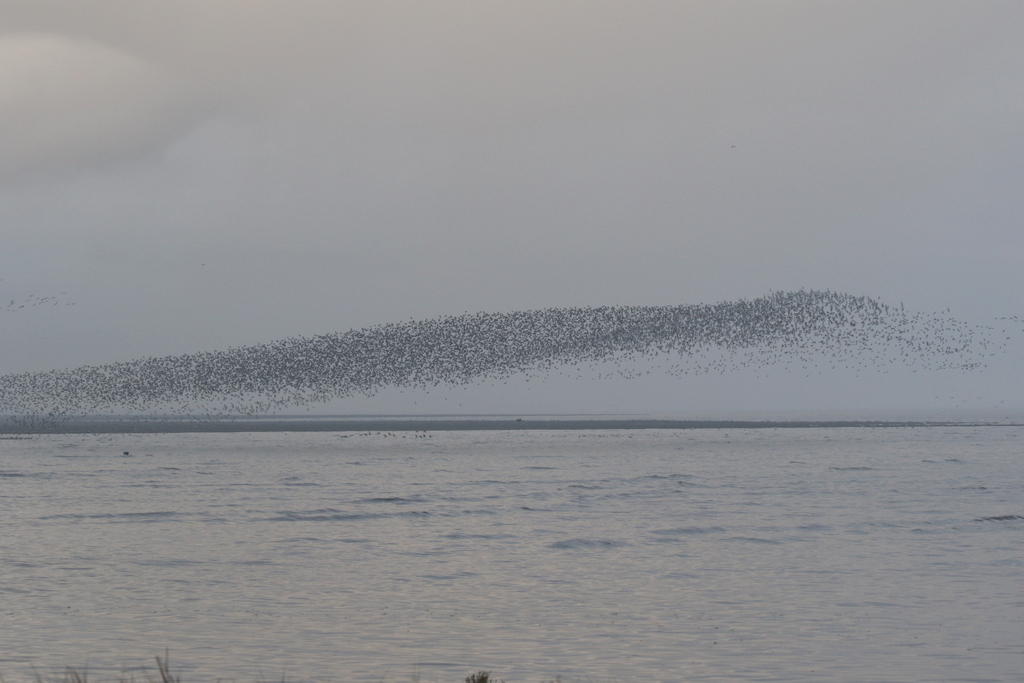
The flocks of Knot swirled and twisted, making some amazing patterns as they turned, flashing alternately grey and white. Then they started to gain height. The Peregrine flew up too, trying to get above them, but it had lost the element of surprise now and eventually gave up.
The Peregrine started to fly in towards us, away from the swirling flocks of waders, high over the water. As it got in over the saltmarsh, it started to fly down until it was skimming low over the ground as it came in over the grass. It accelerated as it flew in, up over the bank before it turned sharply and disappeared down into the pit where the waders were all roosting.
Presumably mass panic ensued, but it was a surprising few seconds before we saw anything. Perhaps they were just hidden from our view, behind the bank, but at first the few Oystercatchers we could see over the far side did not seem to react. Then a large flock of Knot burst over the bank and low over the grass right past us. All we could hear was the whoosh of thousands of pairs of wings beating. A second flock of Knot followed a second later, the same noise. What a sight!
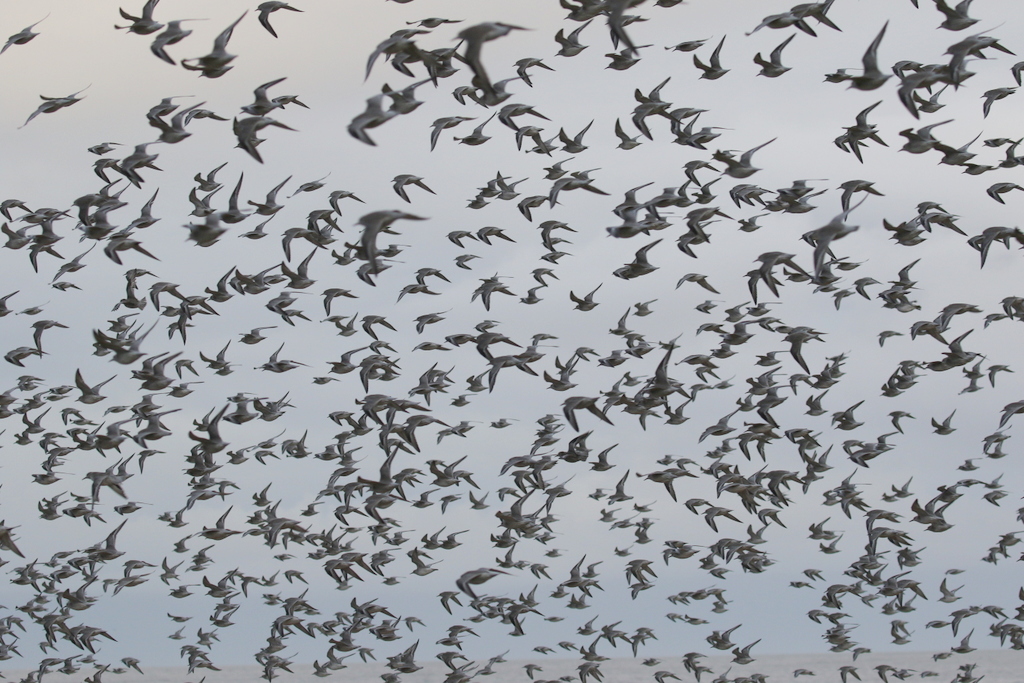
The Oystercatchers were up too now, as were flocks of Lapwing and Golden Plover. Most of the waders headed out over the water again and circled as the Peregrine climbed into the sky again and flew off north, empty talonned. We could see it was a young bird, still a juvenile, so rather inexperienced.
We headed in to the hide now. Once the Peregrine had disappeared, many of the waders settled back down onto the pit. There were lots of Oystercatchers on the shingle banks around the south end of the pit and in one corner they were accompanied by some large and tightly packed groups of grey Knot.
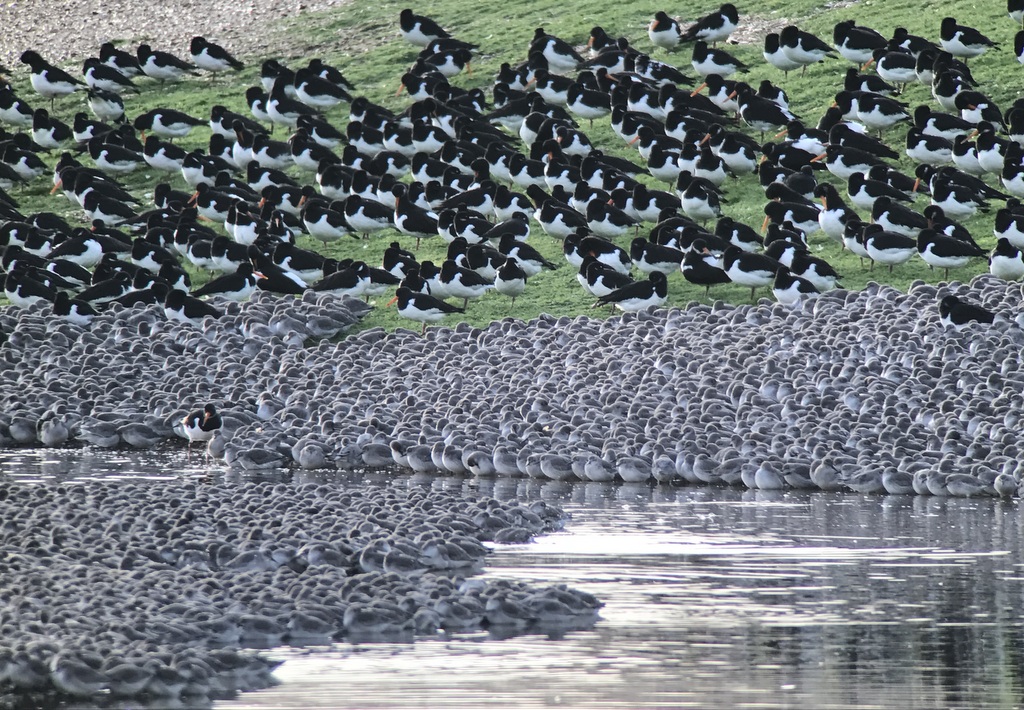
Up the other end, there was a sizeable party of Redshank asleep on the tip of one of the spits. A single Ruff flew in and landed right in the middle of them – we could see its paler face and scallop-patterned back. There were also lots of Turnstone on the rocks out in the middle and a good number of Lapwing scattered all around.
There were plenty of ducks out on the water here too. Lots of Wigeon and Mallard, a few Shoveler and eventually we found a lone pair of Gadwall too, asleep on the bank at the back. There were diving ducks too, a liberal scattering of Tufted Ducks and a good number of Goldeneye. We got a couple of the male Goldeneye in the scope for a closer look – very smart ducks!
The geese on here were almost all Greylags, but a single Canada Goose was with them too. One of the group then spotted a much smaller Barnacle Goose, hiding in amongst the Greylags. We do get wild Barnacle Geese here sometimes, usually with the Pinkfeet, but given the company it was keeping this one was most likely a feral bird.
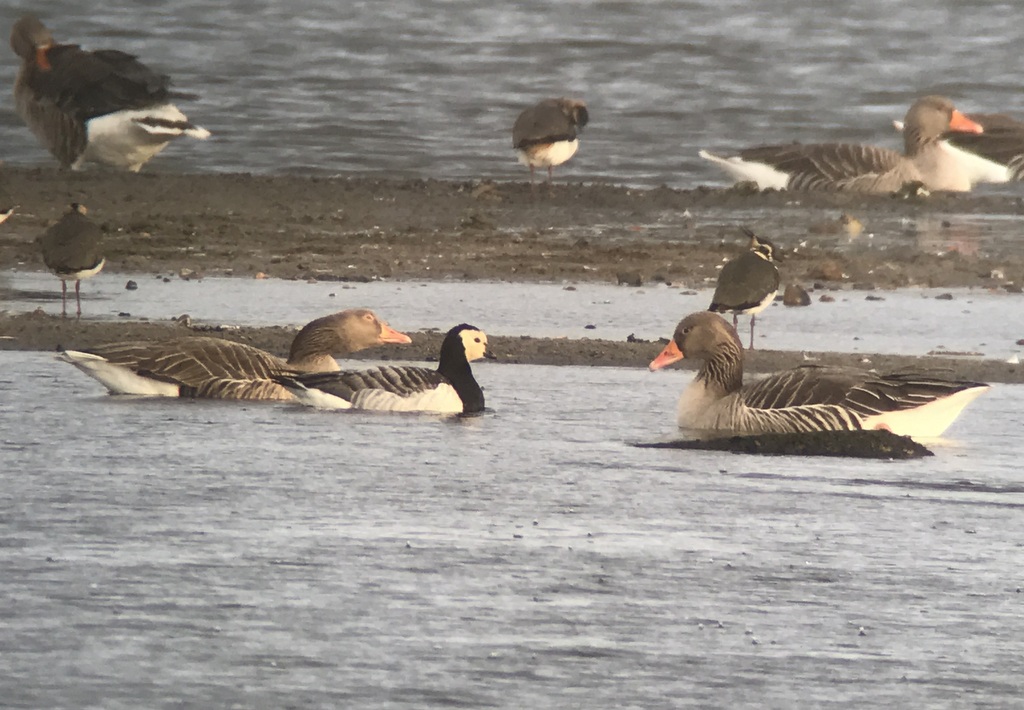
It had felt quite mild here at the start of the day, despite the light mist and a patchy frost inland, but we noticed the wind in our faces on the walk back to the car. It had picked up while we were in the hide, and there was now a noticeable chill. A small flock of Fieldfares flew south over our heads, possibly cold-weather migrants arrived from the continent – we have seen a few along the coast in the past few days.
Round at Titchwell, we stopped at the visitor centre for a warming coffee. The feeders were just in the process of being filled, and as soon as they were they were covered in the usual selection of finches – Greenfinch, Goldfinch and Chaffinch. After the coffee break, we had a look in the ditches either side of the main path on our walk out onto the reserve. We couldn’t see any Water Rails at this point, but a Redwing flew in and landed in the trees in front of us before dropping down onto a post on the edge of the grazing marsh.
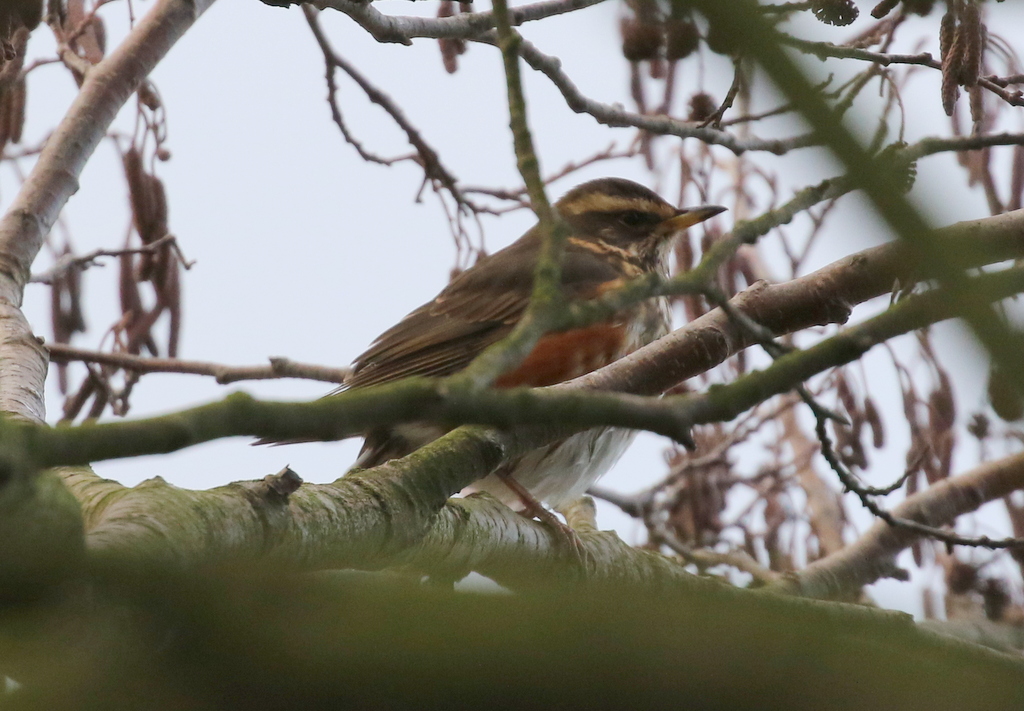
As we walked up along the main path, we could see a few people with telescopes gathered overlooking the grazing marsh pool. They were looking at a Rock Pipit out on the bare ground and as we set up the scope to get a better look at it, we noticed something else moving down at the front, much closer to us. A quick look through binoculars confirmed it was a Water Pipit, the bird we really wanted to see here.
We got the Water Pipit in the scope first and all had a really good look at it down on the mud. We then turned our attention back to the Rock Pipit which was still feeding a little further behind. It was really good to be able to compare these two similar species – the Water Pipit was noticeably much paler below, less dirty looking, and greyer above.
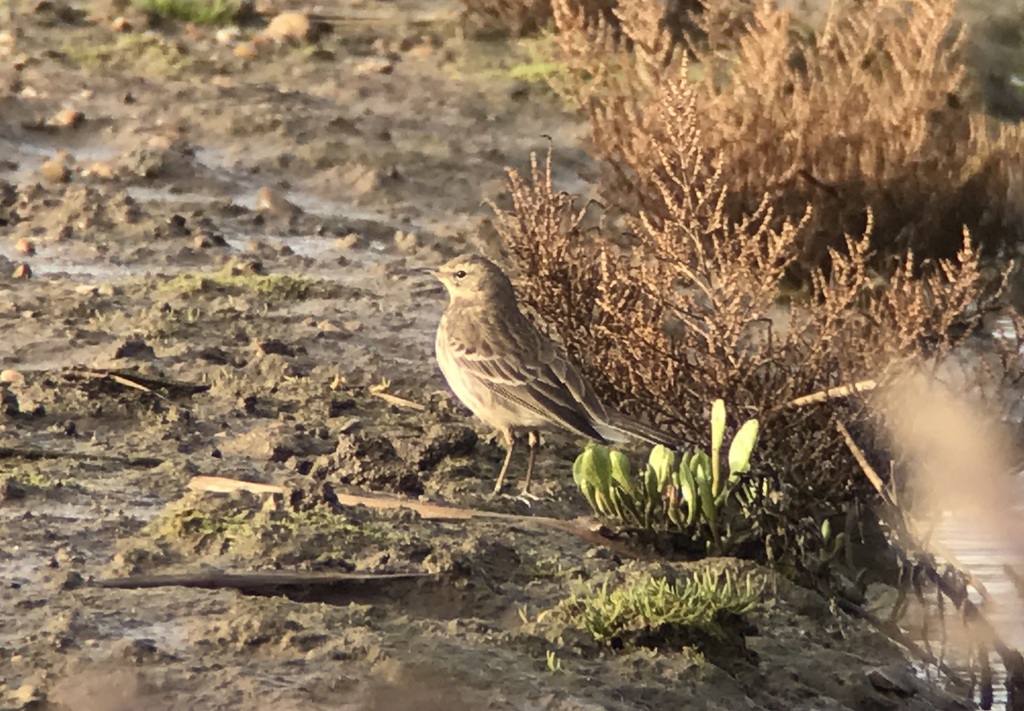
Several Marsh Harriers were circling over the reedbed and a Cetti’s Warbler shouted at us from deep in the reeds. We stopped again to scan around the edges of Lavendar Marsh next. There were lots of Lapwing down in the vegetation and on closer inspection we found four Common Snipe in with them too, feeding in between them, probing vigorously in the mud with their long bills. They were very well camouflaged against the yellow and browns of the vegetation.
There is a lot of water on the freshmarsh at the moment, which the ducks seem to be enjoying. As well as the usual selection of dabbling ducks, particularly Teal and Wigeon, we found a smart pair of Pintail which we had a look at it in the scope. Further back, there were a few Common Pochard in with the larger raft of Tufted Ducks. Several Brent Geese flew in from the saltmarsh and landed out on the water.
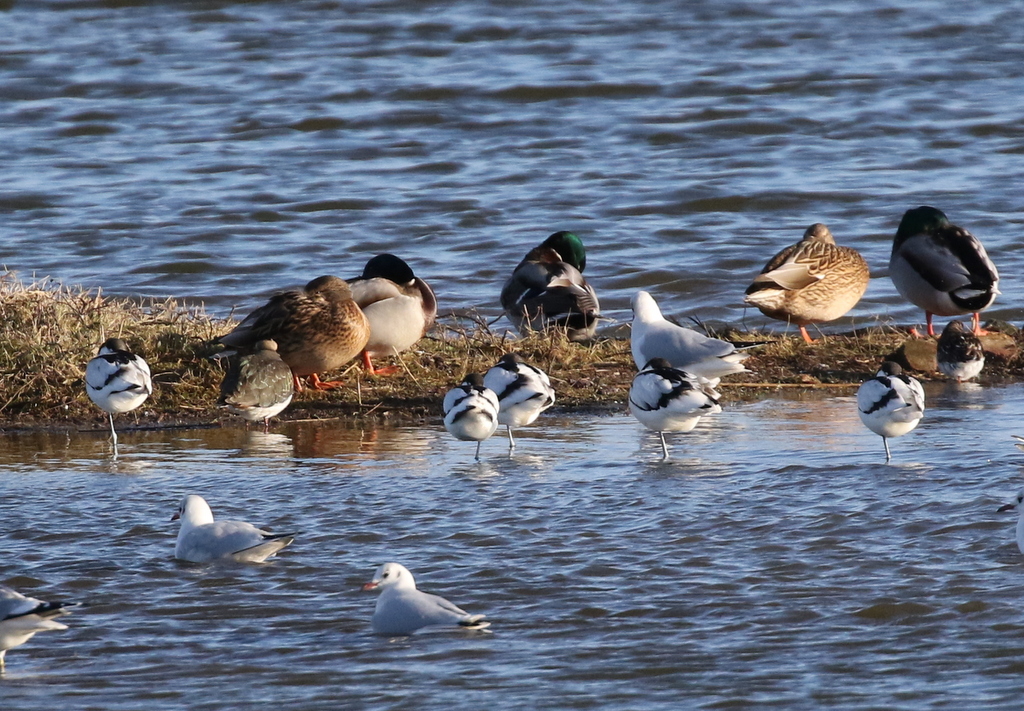
With most of the islands under water, there are not many places for waders to rest here at the moment. Five Avocets were asleep on the small remnant of one of the islands by the path to Parrinder Hide, the brave souls which are hanging on here through the winter, and a couple of Snipe were feeding on there too. We wanted to have a quick look at the sea first, so we continued on up the main path.
There were more waders on Volunteer Marsh – several Ringed Plover, Grey Plover and Curlew. We had just stopped to look at them when we heard a Spotted Redshank call. We looked across to see it fly in and land in the channel at the far end of the marsh. We hurried up there and got it in scope – we could see its pale silvery grey upperparts spotted with white, paler than the Common Redshanks next to it, and its much longer, finer bill.
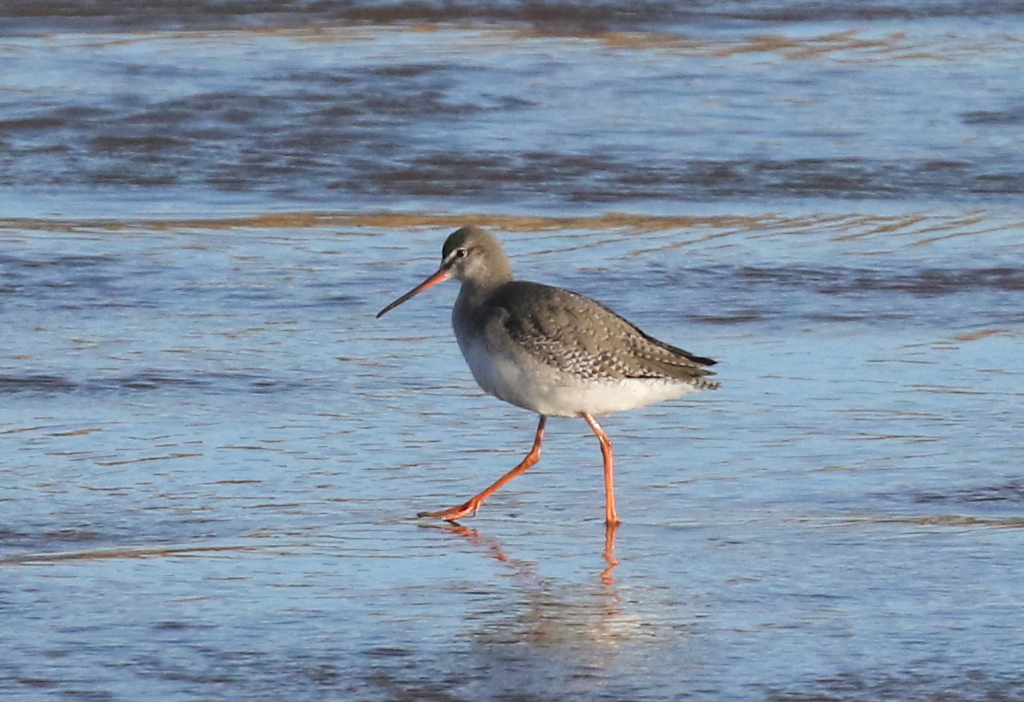
It was cold in the wind out at the Tidal Pools, so we hurried straight on to the beach. Unfortunately the sea was rather choppy now that the wind had picked up and it was harder to see the ducks. The Common Scoter were easier to see, dark black and brown, contrasting against the water, but even they kept disappearing in the waves. Several Long-tailed Ducks were with them and were more difficult to pick out in the swell, despite being mostly white. Eventually everyone got their eye in and managed to see them.
There were a few Goldeneye out here too and we managed to find a single Red-throated Diver on the sea close enough in to see. The tide was still fairly high, so there was not so much to see on the beach today – lots of gulls, and a few Sanderling running in and out between them. It was rather cold and exposed out here today, so we beat a hasty retreat to somewhere warmer!
Back at the Parrinder Hide, with the sun shining now we were looking straight into the light. As well as all the ducks as before, we had a closer look at the Golden Plover and Lapwings which were roosting on the bits of the fenced off island which were not under water. A single Snipe was on the island too.
The light was better on the other side of Parrinder Hide, looking over the Volunteer Marsh. A close Bar-tailed Godwit gave us a good opportunity to look at it in detail. There was also a Grey Plover and two Knot in front of the hide, as well as the usual Redshanks. A small flock of Linnet flew across in front of us.
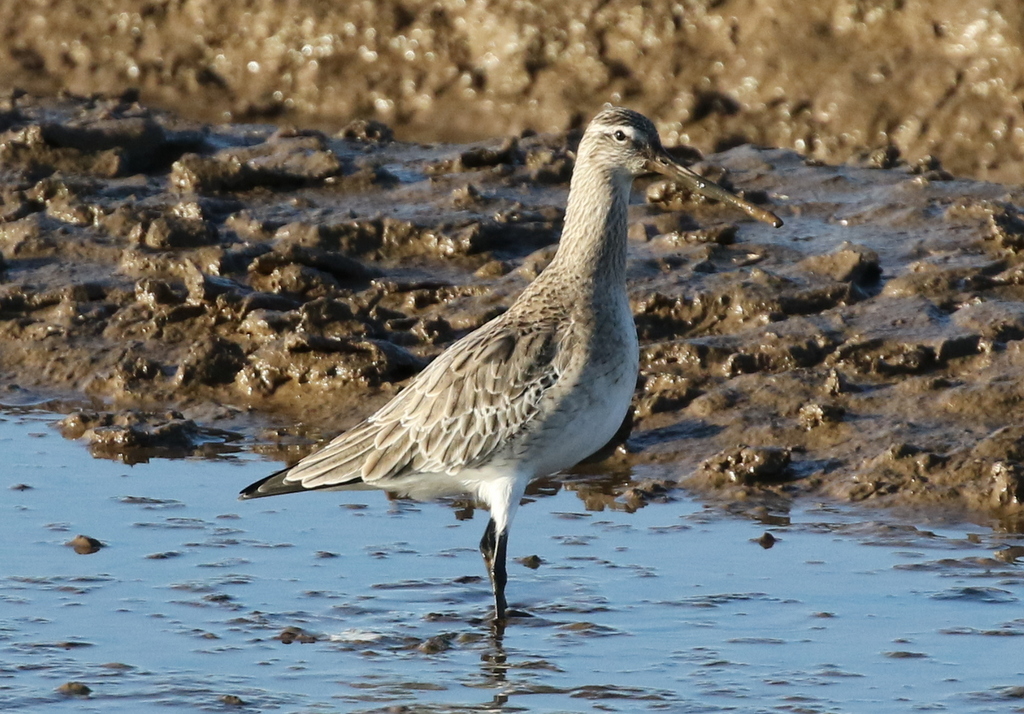
It had been an action packed morning and we still hadn’t managed to stop for lunch, so we headed back towards the visitor centre. As we got into the trees, we scanned the ditches carefully again and this time we spotted a Water Rail just below the path. It was skulking underneath a tangle of branches, and hard to see until you knew exactly where it was. Eventually we all got good views of it feeding in the rotting leaves on the edge of the water.
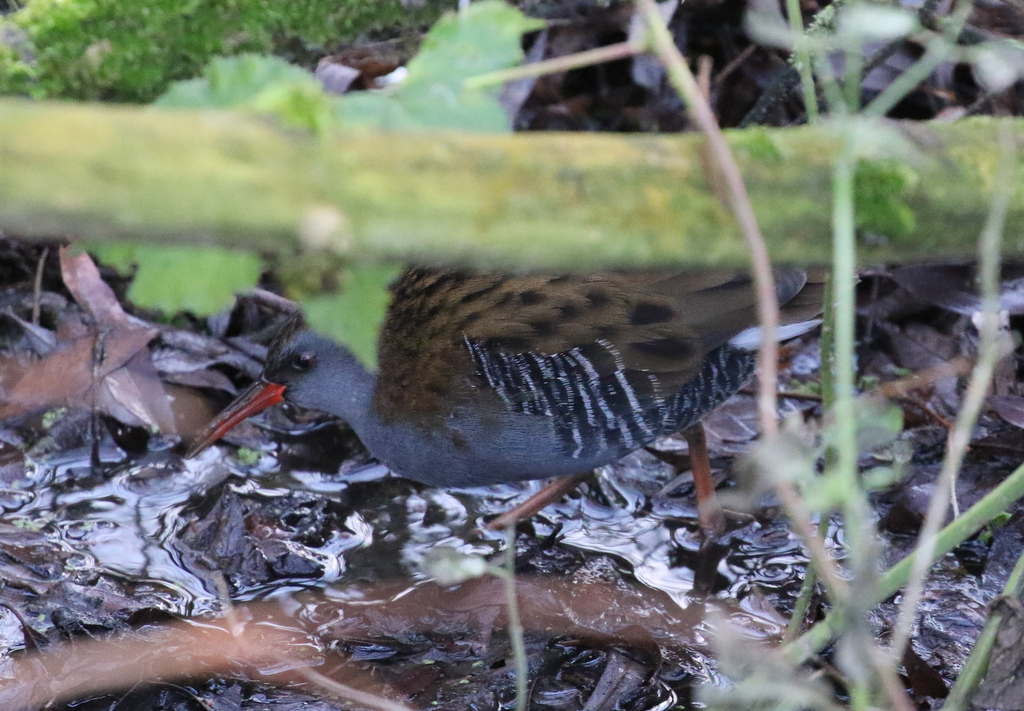
We retired to the pub for a late lunch today. A nice opportunity to warm up over a plate of sandwiches. It was tempting not to venture out into the cold again but we did!
After lunch, we headed inland. We stopped by a cover strip sown on the edge of a field. The hedge alongside was full of birds, mainly Reed Buntings and Yellowhammers, which kept dropping down into the field to feed. A few Tree Sparrows were in with them, we could see their chestnut caps and black cheek spots. A nice bird to see – once a common countryside bird, just a few years ago, they are getting very scarce here now.
Carrying on inland, our next stop was at Roydon Common. The afternoon was already getting on, and the sun was starting to drop in the sky as we walked out across the heath. It was quiet at first as we made our way to the ridge, but we didn’t have to wait long. A Hen Harrier appeared up out of the vegetation in the bottom, a ringtail. It flew across, flashing the distinctive white square at the base of its tail, before landing again on the top of the heather.
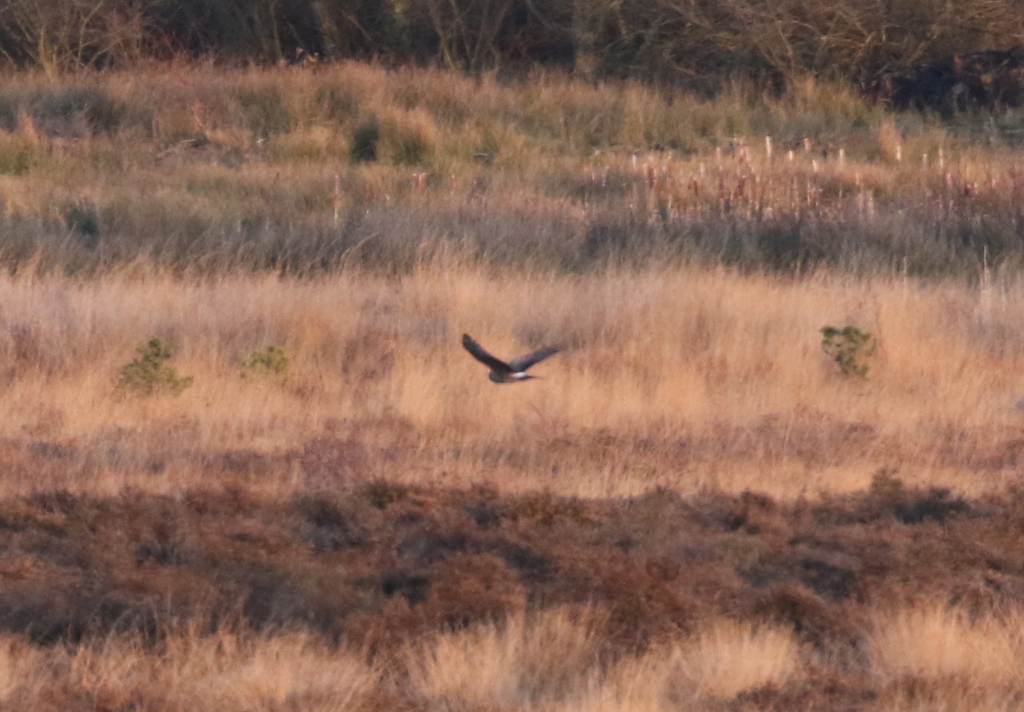
We had a good look at the Hen Harrier in the scope while it perched for some time. Then it took off again and flew low out across the heath, possibly a late hunt for food, over to the far side where it dropped down again out of sight.
As we waited to see if it or another Hen Harrier would appear, we could see a band of dark clouds to the north. It looked like they might miss us at first, but we were just caught by the edge and a mercifully brief shower. It passed through quickly, but the light was really going now, so we decided to head for home.
Sunday 7th January
The next morning, we met in Thornham again and this time headed east along the coast road to Holkham. It was a lovely morning, mostly clear with some patches of cloud, heading in to a beautiful sunrise. It was certainly nice in the car, but cold out of it in a blustery NE wind!
As we drove along the main road, we could see lots of geese in the fields alongside. We pulled up and had a quick scan – they were mostly Greylags, a few Pink-footed Geese too, and then we spotted two White-fronted Geese in with them. This was a species we were hoping to see here today, so we found somewhere to park off the road and walked back to look at them.
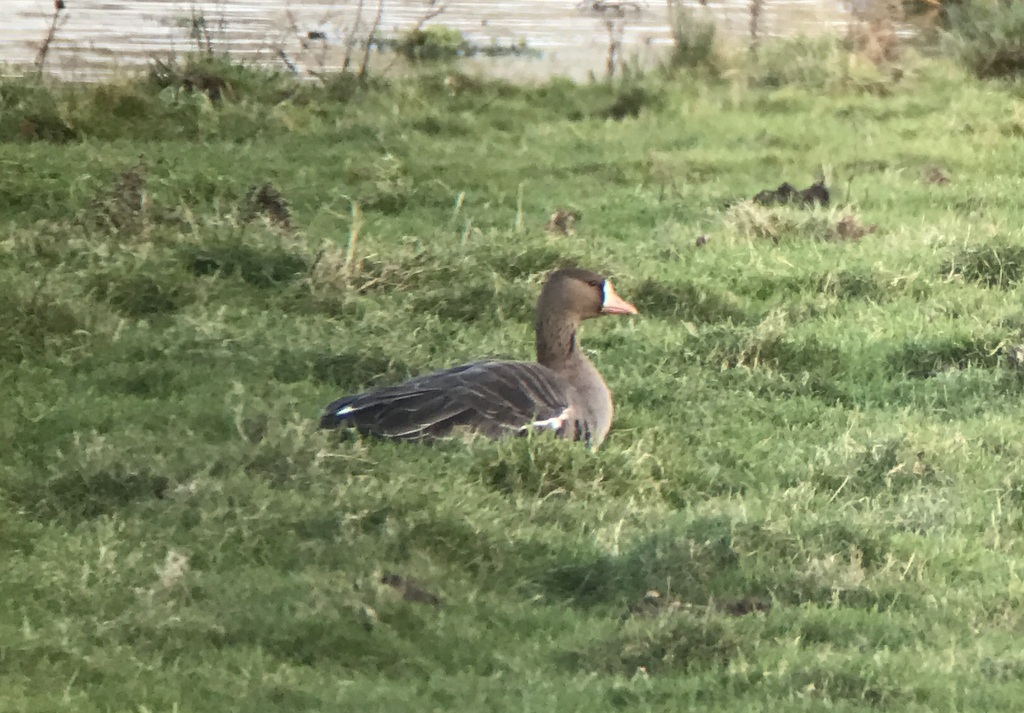
We had great views of the White-fronted Geese through the scope – we could see their black belly bars and the white surround to the base of their bills. We had a close look at the Pink-footed Geese and Greylags too. It was great to see the three species side by side, and get such good comparisons.
After watching the geese for a while, we continued on to Lady Anne’s Drive. As we turned off the main road, we could see several thrushes on the wet grass field next to the drive, so we pulled up for a look. There were several Fieldfares, possibly more fresh arrivals fleeing cold weather on the continent, and two Mistle Thrushes were with them. A little further along and four Grey Partridges were feeding on the edge of the drive, before running off into the field as we approached.
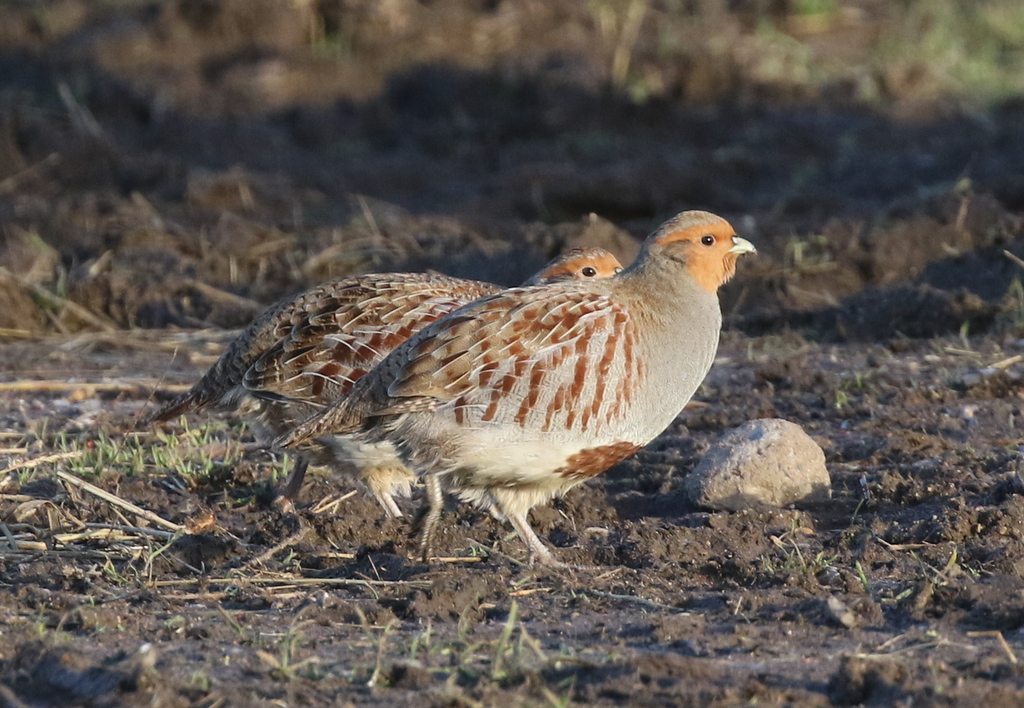
As we parked at the top end of the Drive, we could see three Brent Geese feeding very close to the fence, a nice chance to take a good look closely at our smallest geese, dark slate grey with a white half collar and paler streaked flanks. There were lots more Pink-footed Geese out on the grass and a single Egyptian Goose too.
We made our way out towards the beach first, through the pines before walking east along the edge of the saltmarsh. There were quite a few Skylarks tucked down in the saltmarsh vegetation, along with a couple of Rock Pipits and a Meadow Pipit flew off ahead of us calling.
Our target out here was Shorelark. There has been a flock of eight of them here, on and off, for the last few weeks, but there was no sign of them in their favoured spot when we arrived. We carried on east. As we got out of the lee of the trees, it was cold with the wind in our faces, so we headed across to the comparative shelter of the dunes, where we thought they might be hiding. There was still no sign of the Shorelarks along the high tide line here. We got almost to the beach huts at Wells, but it was exposed and windswept out on the beach beyond here, with lots of people too.
We started to walk back. We hadn’t gone far before we spotted another birder in the distance ahead of us stop and put up his scope. Scanning in front of him with binoculars, we could see eight tiny pale dots running around on the flats – the Shorelarks. We had a quick look through the scope, even though we couldn’t make out any detail at that distance but just in case they flew off, and then we hurried over.
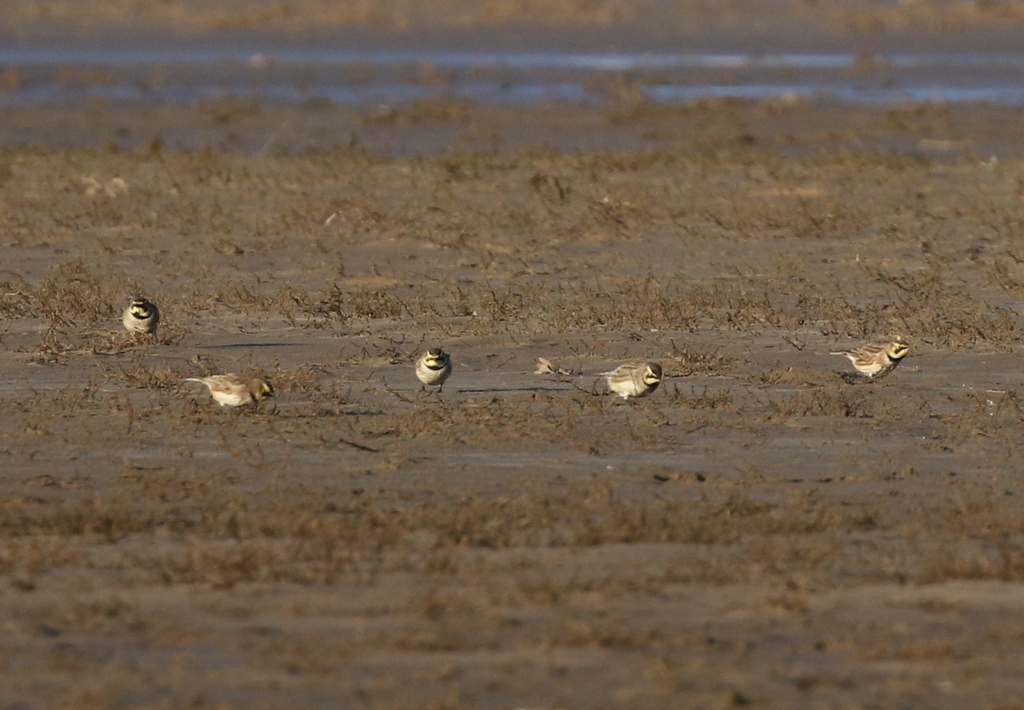
When we got within range, we stopped and got the Shorelarks in the scope. We all had a good look at them, their bright yellow faces catching the sun and contrasting strongly with the black mask and bib. It was just in time – suddenly, for no reason, they took off and flew in the direction we had just come, landing back down on the tideline by the dunes in the distance.
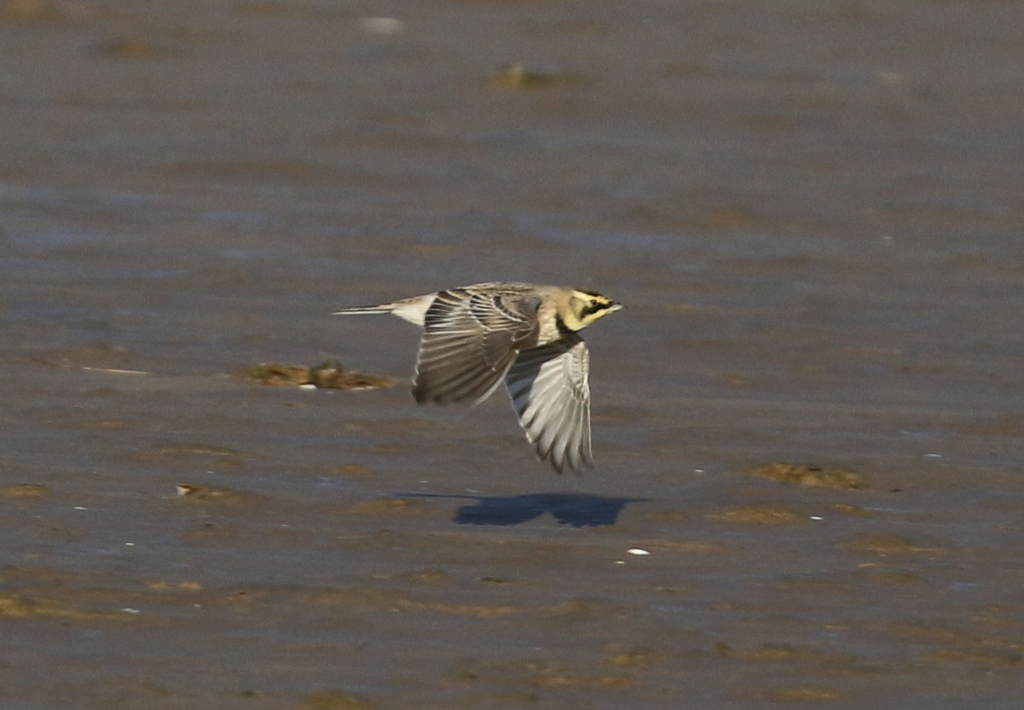
On the walk back, we stopped for a more leasurely look to admire the Skylarks and Rock Pipits on the saltmarsh. We got the scope on them, and looked at the differences between larks and pipits. When they spooked and suddenly all took off, we were amazed at how many had been hiding in the stunted vegetation – at least 40 Skylarks appeared from nowhere!
Once we got back to the pines, we caught some movement in the trees and looked across to see a Treecreeper scaling a trunk. It flew across to another tree and, in typical fashion, disappeared round the back! After we encircled the tree, it had nowhere to hide and it came out so we could get a good look at it.
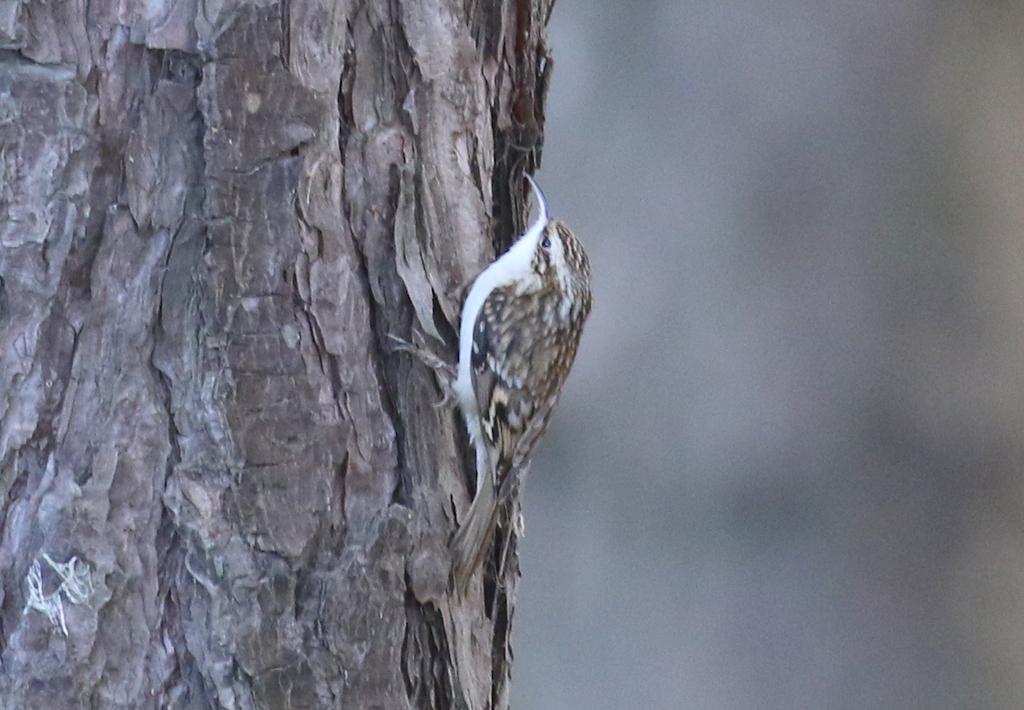
There was more movement above the Treecreeper in the pines and we looked up to see two Goldcrests flitting around in the branches. Unfortunately, just at that moment, two people with a dog walked right in front of us, just where we were looking with our binoculars, and underneath the Goldcrests, flushing them up into the tops. Very helpful!
On the other side of the pines, we walked west along the track. It was nice in the sun here, sheltered from the wind. A pale Common Buzzard flew overhead and disappeared over the tops of the trees. We found a couple more tit flocks in the trees beside the path – Long-tailed Tits, Coal Tits, Blue Tits, and another Goldcrest flashing its golden yellow crown stripe in the sun.
We stopped for a couple of minutes by Salts Hole. Several Little Grebes were out on the water, diving. We watched their feathers puffed out when they were up and the surface and then how they flattened them just before they dived. There were also lots of Wigeon sleeping out on the pool here, the smart drakes with chestnut heads and a creamy yellow stripe up their foreheads looking like it had been painted on. A Marsh Harrier hunted over the grazing marsh behind.
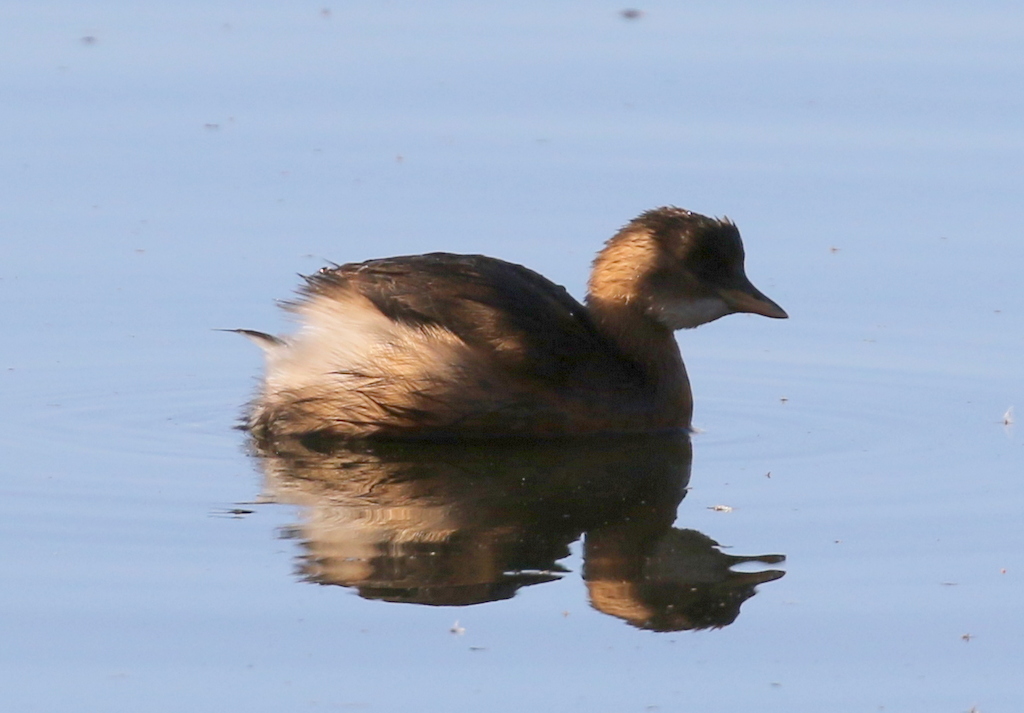
It was surprisingly warm in Washington Hide, the dark boards had obviously absorbed a lot of heat from the sun’s rays, a great place to rest for a few minutes. Unfortunately, we were looking straight into the sun, but the light catching the reeds in front of us was stunning. A Marsh Harrier was hanging in the breeze just beyond and a Common Buzzard was perched on bush behind that. As we were looking at it, a Red Kite was flushed from the grassy field behind by another Marsh Harrier. It landed again, and was mobbed by a third Marsh Harrier having a go at it.
Eventually, we had to tear ourselves away from the warmth of the hide and we made our way back to the car. When we got to Lady Anne’s Drive, a Red Kite was hanging in the wind over the grazing marsh in front of the car, possibly the same one we had just been watching.
We only had a half day out today, so we started to make our way back west. We arrived back in Thornham with a little bit of time to spare, so we made our way out to the Harbour. There was no sign of any Twite around the car park today, but it was very busy with lots of people out for a Sunday stroll. There was lots of disturbance – a couple of boys strangely decided to walk right out across the thick mud from the car park to the seawall – and in entirely unsuitable footwear!
Up on the seawall, it was exposed and very windy now. There were several Redshank scattered around the harbour channel and a lone Curlew was huddled up asleep, trying to shelter behind a spit of saltmarsh vegetation, out of the wind but catching the sun.
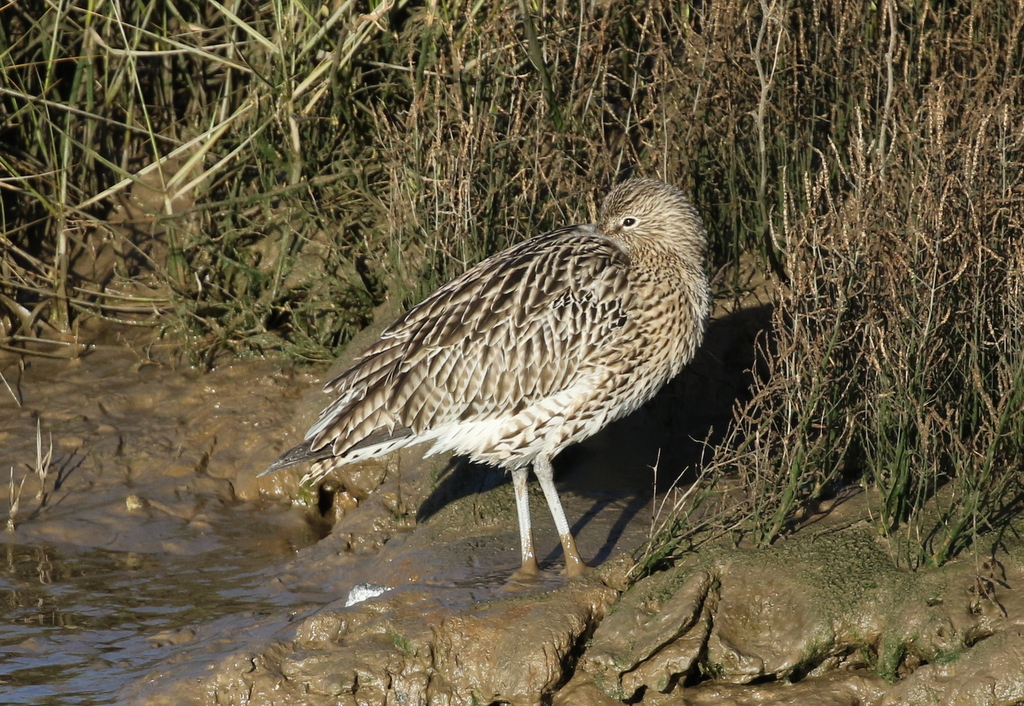
We walked a short distance out along the seawall. A female Stonechat was working her way along the fence line on the edge of the grazing marsh below the bank, flying down to the ground and back up to perch on the next post along. This is another area the Twite often feed, but it was no quieter here – a dog ran down the bank and out onto the saltmarsh, chasing back and forth across the muddy channel trying to catch the Redshanks, which just flew off calling.
Unfortunately, we were out of time, so we turned and headed back to the car. We were almost back to the car park when we glanced across the saltmarsh to see a bright blue jewel sparkling on the mud the other side. It was a Kingfisher. It looked absolutely stunning in the sunshine, against the dark oily brown muddy bank on which it was perched. We stopped to admire it.

The Kingfisher was a fitting way to end the tour, one and a half days of great winter birding on the North Norfolk coast. Then it was off to the warmth of the pub for Sunday lunch.
















